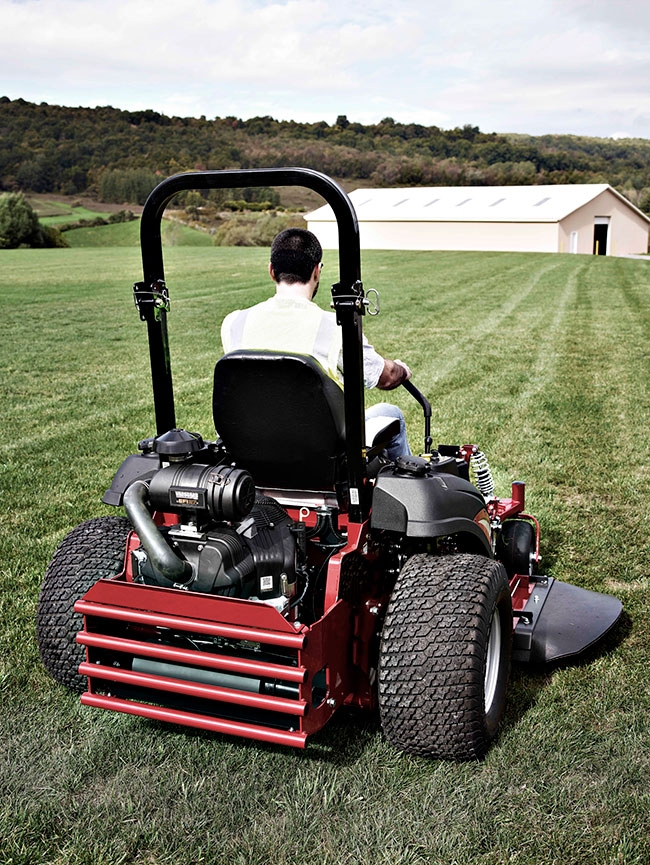
Features
Profiles
Spring start-up tips for engine success
Get the most out of your engine by following these tips.
March 7, 2018 By Tom Billigen
 For commercial turf applications, EFI engines provide better fuel economy than carburetored engines.
For commercial turf applications, EFI engines provide better fuel economy than carburetored engines. Increasing productivity and limiting downtime is – and always will be – a top priority for landscape professionals. As contractors put away winter equipment and start prepping cutters and trimmers for spring, it’s important to make sure everything is tuned up and running efficiently.
While sharp blades, greased fittings and sunshine all factor in to the success of the season, it’s important to remember what’s at the heart of your equipment – the engine. Here are a few engine tips to keep in mind this spring, whether you’re using EFI, propane or regular, carbureted gas engines.
Start the year fresh
Getting the most out of an engine starts with the fuel you put in the tank. The most common reasons engines sputter out early in the season are fuel related. Since fuel refineries gear products toward the automotive industry, the amount of chemical additives in gasoline fluctuates seasonally to improve performance based on the conditions.
Winter blends are particularly problematic for outdoor power equipment because they’ve been formulated to be more volatile in order to promote reliable combustion in cold weather. As a result, the gasoline has a shorter shelf life since the more flammable molecules evaporate quickly. When the temperature heats up, winter blends can literally boil inside the tank of a small air-cooled engine, resulting in poor performance and possibly vapor lock. To avoid any problems, be sure to start the season off with fresh, season-appropriate gasoline.
EFI
As EFI engines continue to become more and more prevalent in the industry, it’s important to keep in mind the differences in seasonal maintenance. Compared to carbureted models, EFI engines are generally less susceptible to stale fuel damage. However, improper winter storage can still result in damage to the fuel system, and will almost certainly require a trip to the dealer.
By treating the engine with fuel stabilizer before storing it, components such as the fuel pump module and injector spray tips – which are expensive to replace – will remain safe from the damaging effects of stale and gummy fuel. If the proper steps are taken in the fall, EFI engines can simply be topped off with fresh fuel in the spring.
Propane
Propane engines – like EFI – are also becoming more popular with commercial turf contractors. Since propane does not degrade quickly, the way gasoline does, these engines also require minimal attention in the spring.
One important thing to be mindful of with propane engines is the spark plugs. Propane spark plugs are nearly identical to gas spark plugs, and in some cases even have the same part number. However, the spark gap for propane combustion is narrower – a whopping 10-thousandths of an inch narrower.
This miniscule gap difference intensifies the spark and, because propane is more difficult to ignite than gasoline, can make all the difference in the world when it comes to the engine’s performance. When purchasing spark plugs, be sure to specify they are for a propane engine. If there’s any confusion, the engine’s manual should specify a recommended spark gap.
For propane engines, it’s also smart to inspect the fuel system from time to time for signs of wear. Check the system’s rubber fuel lines for cracking or signs of dry rot. If a leak is suspected, spray the area with a mixture of soap and water to check for bubbles, which will confirm the presence of a leak.
Breathe easy
For air-cooled small engines, fresh air is vital for sustaining peak performance. Spring equipment tune-ups are a great time to check air filters to ensure that no regular service intervals have been missed. A clogged or old air filter will restrict airflow and adversely affect the air-fuel mixture, resulting in decreased horsepower and fuel economy.
Even if an air filter looks clean, stick to the manufacturer’s suggested service intervals. Many of today’s newer filters can hold a lot of dust before it becomes visible. This is especially true for engines with cyclonic air filtration, since large particles – the ones we can easily see – are ejected before reaching the filter.
Taking a little extra time at the start of the season to make sure each piece of equipment, particularly the engine, is tuned up and operating properly, can go a long way toward reducing downtime as the season wears on.
Print this page